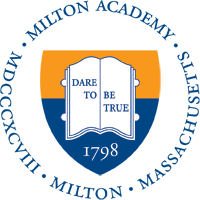Graduation 2007
One-hundred-eighty-four seniors received their Milton Academy diplomas during the School’s commencement exercises on June 8, 2007. A longstanding tradition of the ceremony is the election of student valedictorian speakers to assure seniors that they will, at their last Milton gathering, hear from classmates they have chosen. This year’s student body elected Kabeer Parwani and Jee-Ahn Suh. Delivering the commencement address was alumna and artist Sarah Sze, Milton Academy Class of 1987. Sarah is well known in the United States and around the world as a compelling contemporary artist. Her sculptures and installations are intricate works that use objects of everyday life in expansive or even dizzying relationship, making spaces come alive.
Speech by Kabeer Parwani '07
I’d like to start with a little audience participation. Close your eyes and think of your hero. You just see them, and the way they handle themselves, in situations, and you think to yourself, that is who I want to be. And you aspire to be that person every day. Now I want you, in your mind’s eye, to imagine my hero next to yours: I’ll describe him for you. My hero’s name is Mark. He’s tall, not impressively tall, but awkwardly tall. The kind of tall guy that hits his head on nearly everything in sight, and gets a “dude what the hell” face from people when he admits that he can’t dunk. He dresses like a golf caddy, walks around with a stupid grin on his face, and, even though he lived his whole life in Massachusetts, inexplicably has a British accent. Ok now you can open your eyes. All of you that already opened your eyes, well…you should really learn how to follow directions. I’m sure my hero isn’t nearly as impressive as the John F Kennedys, Eleanor Roosevelts, or Frank Millet’s of the world that you all are imagining, but I did have the pleasure of having him as one of my best friends growing up. From the time we were young, Mark was always trying to prove that he was smarter and more mature than the rest of us, mostly by sharing his insights and musings on life. Little one-liners that could have been found in fortune cookies. Every once in a while though, Mark would come up with one that would truly speak to me. One such little gem, “pearl” if you will, of wisdom was this: “If you are ever faced with a difficult problem, there are probably two choices. the smart thing to do, and the right thing to do.” First let me clarify the words smart and right. Smart, as Mark meant it, does not mean what we traditionally think of as smart, like the most intelligent solution. Smart means what everyone else thinks is smart. What your parents or your friends, or the academic community at large think is best for you, or is the correct course of action that your life should take. Next, the word right. I know right is a very loaded word, with all these moral connotations. Drop all that off the word for a second though. What’s right, is what your conscience tells you. That natural impulse that you can try to fight, but you never really feel good about going against. We all have an instinct for what’s right, but how much we listen to it can change as we grow. Now I know what you’re thinking: There are plenty of problems, where there is one clear choice that is both smart and right. Think you’ve got me? Well then I hope you don’t go to Milton, because you weren’t listening very carefully. I said difficult problems had these two choices…that’s why they’re difficult. My seemingly British friend Mark held the belief that any time we are indecisive, it’s because we are choosing between what we think is the smart thing to do, and what we know, deep down, is the right thing. These ideas of Mark, which I like to call Marxist thought, have come up numerous times in my Milton career.
Milton Academy is a community of some of the finest individuals I know. I’m not giving a sound byte for the admissions office either, it’s true. While some prep schools methodically break apart a student’s individuality in order to create the perfect college applicant, Milton encourages us to be ourselves to our fullest potential. As wonderful as that is, it is sometimes difficult to get away from thinking of Milton as being all about us. Too often, I see myself, or someone I know, breaking Mark’s philosophic rule of life.—We go to a very high-pressure school. I know that this is news for many of the students in the room, but try to bear with me on this. I just think that at one point or another some of us will try too hard to do what we think is the smart thing, rather than what we know to be the right thing. There are times when we can be so caught up in the work, that we can forget to take care of ourselves, and more importantly, each other. Often we are afraid to put aside an assignment for just a moment, to take care of our friends, because we are worried it would not be the smart thing. It’s smart to do your work as soon as possible. It’s smart to not answer the phone when you’re studying. It’s smart to leave your friends alone when they need you most. The reason that you feel the pang of guilt when you ignore the people that love you to finish an assignment is because you know you haven’t done the right thing. But its ok…you’re being smart.
As I look back on my time at Milton, the memories that I remember most fondly, are those when I did not compromise, when I did not sacrifice what I knew to be right for what I thought to be smart. For example, freshman year, when I spent all of my free periods in a class-wide rock, paper, scissors tournament when I should have been doing my workshop homework. Now I’m not about to stand here on my graduation day and ask all of you current students to not work hard…but…don’t work hard! I’m not saying you should throw your life away in a foolish, self-destructive, adolescent rage, but do remember that sometimes taking time off from work doesn’t always lead away from ivy league campus gates and towards the career of a dog walker. Parents, I know that this can be difficult to hear, but your child is not a failure if they don’t get A’s all the time. Sure, ok if they get a C, put them out on the street, they deserve that, but a couple of B+’s? come on. Sometimes we need to take a step back, and settle ourselves a little bit. Ask yourself, what am I really doing here? Am I really triple-checking an assignment at the expense of a good night’s sleep? Is that the right thing to do? Actually its not the smart thing to do either. Once you’re at the stage where you’re triple checking minor assignments, its time to get some help.
Someone once told me that there are three types of New England Prep school students. Imagine three kids walking down the sidewalk. The first is looking down at the ground. He symbolizes the student that is always worried. “did I answer all the questions right on that chem test? Have I studied enough for the in-class essay? Is my class IV talk well-rehearsed?” The second student walks with his head pointed straight up at the sky. He sees high school as another rung on the ladder to college. He thinks, “have I done enough community service to put on my application? Am I the head of enough clubs? Is tour guide of the month as impressive as I think it is?” The third student walks with a level head. He keeps his eyes focused on what’s going on around him. He waves to his classmates, gives a friendly nod to his teachers, and stops to talk with his friends. This is the kind of person Mark encouraged me to be. Whenever I would complain to him about a math exam or a big history paper, he’d take me aside, and remind me to that third prep school student, with a level head.
Even though Mark was always full of little tidbits of wisdom, he was an easy guy to ignore. His peculiar accent and awkward height insured that it was almost impossible to ever take him seriously. I lived my life, with Mark’s ideas as background noise. All that changed though, when earlier this year my quirky friend Mark passed away. At his funeral, I could no longer pass off what he said as just Mark being Mark. Everything he ever said to me began to resonate with a heavier tone. I started to question myself. Am I who he wanted me to be? Am I who I want to be?
When I was younger I used to be a big fan of the Calvin and Hobbes comics by Bill Waterson. I remember one particular strip in the collection entitled “it’s a magical world”. The scene is one of the hallmarks of the Calvin and Hobbes collection, the twosome on a sled, on one of the many hills that seem to make up the acres of Calvin’s backyard. As they prepare to head down, Calvin turns to Hobbes and says “In the short term, it makes me happy to go play outside” in the second panel, he says “In the long term, it would make me happier to do well at school and become successful.” In the third panel, he says “But in the very long term, I know which will make better memories.” And with that, he takes off down the hill. This is high school. The best time of your life. As Milton Academy students, we will all go off to do amazing things, and change the world, and come back and maybe even donate a building, or some art or something. But no amount of degrees, awards, and Nobel prizes will ever compare to the memories that you have made here. So do yourself a favor, and make the most of your time. And take my Mark’s advice, and please…please…try to be significantly less smart.
Thank you.
Speech by Jee-Ahn Suh '07
Ms. Sze, Mr. Hobbs, Dr. Robertson, members of the Board of Trustees, members of the faculty, staff, family and friends, and the graduating Class of 2007, hi and good morning to you all.
Junior spring, a year ago, the College Office sent out a mock college application or the student response form questionnaire to help us get started with the whole college fiasco. At the top of the document, there was a whole section about how this mock application is designed to get me thinking seriously about college and my future. “An effective search must begin with an honest self-assessment. Please answer each question as honestly as you can.”
Alright, so it’s the night before the mock app was due, and I’m on mock question #6 out of mock 10 and I still had a mock essay to write afterwards. Question #6 read, “At this time, what personal, educational, or vocational goals do you have in mind? What areas of study might you like to pursue in college? Do you have any clear idea about what you hope to do after graduating from college? Where do you see yourself in ten years?” And then in parenthesis the college counselors wrote “Have fun with this one” with an exclamation mark at the end. Haah~
Oh-kaay. So, one, it’s past midnight and I still have a boatload of history reading to do; two, talk about overload; and three, the college counselors messed up ‘cause that’s definitely four questions, not one. But it got me thinking. All of a sudden, it was like time had momentarily stopped and bits and pieces of my childhood were flashing before my eyes.
I remembered being a little girl, 4 or 5 years old, dressed in red pajamas, standing on top of an overturned laundry hamper, pretending I was singing on a stage. I remembered playing ‘tea-time’ with my dollies, I was the amazing chef who could whip up a full course meal out of thin air. Then I was the Greek goddess Hera in my elementary school play, sitting on a box…and doing whatever Zeus told me to do. Fast-forward to about age eleven when I mastered all four styles in swimming. Skip middle school cause that was just terrible. Freshmen year, in Korea, okay yea skip that too. And finally, sophomore year, I ended up traveling 6800 miles away from home sweet home, Seoul, South Korea, to live at Milton Academy…learning things I’d never heard of and doing things I’d never imagined.
Amidst my late night session of childhood reminiscing, I became aware that I have been in search of the answer to question number 6 since my red pajamas days. Theoretically, we all have been. And, the light-bulb went off and I realized that there is no right answer to number 6. As a matter of fact, I don’t think there ever will be a final full stop answer to question number 6. There’s always the ‘what if’ factor. ‘What if I took my music seriously and devoted all my time and energy to singing?’ ‘What if I committed to pre-med and ended up in training for the next ten years? ‘What if I dropped out of college like Bill Gates and created a company called MICRO-SUH…?’ Hah.
The search for the answer to question number 6 is like a ‘Choose your own adventure’ book. Each choice you make sets you off on a different route towards the end of the story. Each choice you make will lead you to a new question and you’ll have to make another choice: do you stay and accept the prince’s challenge to a sword duel? Turn to page 4. Or do you run? Turn to page 8. You won’t know until you try. You’ll never know for sure what’s coming up. You may know what you’re doing one day, but not the next. You may have a vague idea of what’s going to happen…but not really; and that, I find, is such a thrill. The ‘what if’ factor can determine all.
During my red pajama days, I always wanted to be something along the lines of a singing-diva. I only know this because it’s on video. Yea, my mother and father were obsessed with technology and have documentation of every breath I took as a child. Then the diva dream soon changed into a chef, a doctor, a teacher…really the list is endless. Yet twelve years later, there I was bleary-eyed and exhausted in front of the computer with question number 6 still blank. Yea, being a doctor or a diva would be amazing; but I was calculating risks and consequences. This whole honest self-assessment thing was getting to my head and I couldn’t bring myself to answer anything. But I’ll let you in on a little something: it’s okay to not know your answer for question number 6.
Class of 2007. At this time of year, many people wish us the best of luck in our years to come and tell us that we should never give up on our dreams. I know what they mean, and I would like to say the same to you all. But, by saying “Don’t give up on your dreams,” I’d be contradicting myself in asking you all to live in the future. Rather, I would like to say to you, as clichéd as it sounds, to “Live in the now.”
By obsessing over what you’ll become or what the world will be like in 10 years, you’ll be locking yourself onto a fixed path. There’ll be no “Choose your own adventure” story there. You’ll be too busy to even think about the ‘what if’ factor. Everything you do will be for and towards an end. Which isn’t bad, well actually it’s really really good that you’re driven; but before you know it, you’ll be denying alternate opportunities and assuming outcomes before they even happen…because you know what outcome you want, or at least you think you do…so you make choices based upon that.
Over the past three years at Milton, I’ve learned to ask ‘why?’ And often, ‘why not?’ or ‘why can’t I?’ It’s like I’ve become the annoying child who asks ‘why’ to everything. So when I ask myself ‘Why is Bill Gates so great?’ I realize that it’s because he didn’t dream of becoming the next Einstein. He dreamed of being different. He dreamed of being unique. Well, no, specifically, he dreamed of each American household to have a personal computer system. But you get the picture. He acknowledged his ‘what if’ and embraced it.
I did end up answering question number 6 last spring. And I wrote the following. “I am sure of one thing: I don’t think I will ever be completely sure of what I want to do in college or after college until I’m actually there. But in ten years I hope I am happy.”
So, fellow graduates. We are 184 ridiculously talented, unique individuals, who each have had different Milton experiences. We’re all equally equipped with the tools necessary to find the maybe existent, maybe non-existent answer to question number 6. But I wish that in ten years, we will all have embraced our ‘what if’ factors and that we are all very very happy.
Thank you.
Speech by Sarah Sze '87
Thank you for having me here today.
Before I start, I would like to make a confession. In preparation for writing this speech, I took the opportunity to go back and read some of my teachers’ comments from when I was a student at Milton that my mother had kept for all these years. I came across this rather sobering evaluation, which I would like to share with you today:
Date: June 5, 1987
Subject: Public Speaking
Teacher: Deborah E. Simon
Grade: B-
“Sarah, at the beginning of this year I saw in you the potential to be a very fine speaker. Before each speech I was hopeful that this would be your most powerful effort. In all of your presentations there were fine elements—voice, your opinion of a particular source, your use of the outline. But unfortunately I never thought you totally pulled it together in one, polished effort…I’m not sure what got in the way of your presentations in this class—absences, attitude, lack of preparation. But Sarah, you have the makings of a very fine speaker. I wish I could have seen your strengths more often.”
So I am back again for one last try.
Reading through these piles of detailed comments, I was reminded of how, as a student, ones performance is being watched and evaluated at all times. In light of this, I would like to start by giving you something that Milton might not have given you while you were here. I’d like to give you all the permission to fail.
It’s an ugly word that means different things to each of us. But in certain crucial situations, the permission to fail means the freedom to take meaningful risks. And in certain crucial choices, such as choosing to do what you love, the practice of being too cautious could be the greatest failure of all.
I am an artist. It is a career that, perhaps uniquely among professions, is vigorously encouraged in children and then vigorously discouraged in adults. After being vigorously supported and encouraged by a remarkable art faculty here at Milton, I arrived at Yale in the fall of 1987. I was studying art along with four other subjects. A live model would come to my painting class every week, pose for an hour, and we would paint a likeness on canvas—a method of teaching painting that probably dates back to the very beginning of painting itself. I had the ability to paint quickly and to capture likeness, and this ability served me well. Studying art is a very public, group endeavor, and at the end of each class, when the easels were all turned and the canvases lined up, there was no doubt that mine stood out. Studying art became like a competitive sport.
But when I look back at those paintings, what strikes me is only their technical virtuosity. The skill was evident and self-assured. But I was only fulfilling exercises, jumping through hoops.
And then, in a bizarre turn of events, my dorm room burned down. A fire had caught in one of the old college chimneys and spread through the floorboards. I climbed the stone stairs of my entryway only to find the black, soaking shell of our common room. I scanned the room with a dull sense of disbelief. But it was not until I saw the remains of my painting—a painting that I had done at Milton Academy and brought with me to college—that I was surprised by a profound sense of loss. It was a painting of about three by four feet, and on the wall where it had hung, oddly, there still remained a skeleton of blackened stretcher bars, the canvas of the painting perfectly singed off. I lost all my belongings in that fire, but when I thought about what I might have saved from that room, the only object I could think of was that painting.
The loss of the painting was a good thing, not only because it was a dramatic indication of what I cared about, but also, because it was one of many paintings that I had produced at the time that were primarily paintings in which I was concerned with showing off my skill as a painter. It was a skill for which I had always gotten approval. The seduction of that approval would have to be destroyed in order for me to move beyond making artwork as simply an academic exercise.
The painter Philip Guston once said, “The basis for creativity is one’s willingness to risk embarrassment.” By the time I left college I was bored, and most lethally I was bored by my own paintings. I had finally figured out what the artist Nam Jun Paik meant when he said that he would “rather make a new mistake than an old success.” It was time for me to make some new mistakes.
It was just a few days into graduate school at the School of Visual Arts in Manhattan. I went to class expecting the usual encouragement and support. The teacher for critiques that morning was the artist Jackie Winsor. “Who cares if you’re talented?” she said. “You wouldn’t have gotten this far if you weren’t, and nobody cares. The great majority of you will give up making art within a year after graduating—if you even make it through. The few who survive will be the ones who are able to work through the bad work. The creative process is not a steady climb upward. It’s ups and downs. Whether or not you’ll be resilient, that will be the real test.”
That didn’t sound like Anne Neely. I knew my paintings on the wall were not going to cut it. I packed away the tentative paintings I had eked out and decided to clear the room until it was reduced to a white, bare box. I tried to forget what a piece of art should look like. I went out to the corner store and bought a selection of materials—materials that I could experiment with, that were not precious and laden with history of painting; I bought materials that were cheap, dispensable and everyday, but that were somehow staples: rice, spaghetti, toilet paper, cheese, erasers.
When I arrived back at the studio building, the elevator was broken. My studio was on the ninth floor. Climbing the stairs with the plastic grocery bags cutting into the creases of my fingers—primarily from the weight of the four bags of rice—I imagined putting a grain of rice on each stair and watching the piles accumulate as I ascended. I couldn’t get this vivid image out of my mind, and after the second floor, against my better judgment, I decided to try it. I returned to the ground floor and started at the first step, placing one grain on the first stair, then two on the second, three on the third, until I had reached the 288th stair with a pile of 288 grains that marked the ninth floor on which my studio was located.
Looking down the vertical drop of the stairwell, the descending, shrinking piles in the distance had a life of their own. They were provocative and would be discovered unexpectedly by the viewer. They surprised me. The work sat in between painting and architecture, decidedly outside the traditional form of sculpture.
In the history of art, sculpture is typically an object. Its value is traditionally signaled by the worth of its constituent materials—gold, bronze, ivory, ebony, marble, in the most traditional forms. But what if value lies in an event, or in an intention, even if it is a failed intention? What if it lies in something that can be destroyed and easily can be remade—in fragility, in evanescence? The rice piles were like the leftovers of an event. The act was barely there—so slight that it was nearly invisible—but the process absurdly rigorous.
In the years that followed, I made sculptures out of everyday materials, trying to imbue value into ordinary objects: ladders, plants, lights, Q-tips, paper, cloth and flowers. I made them in non-traditional locations—outside the white boxes set up in galleries and museums, in places they would be discovered unexpectedly by the viewer, not presented to them. I buried pieces underground and hoisted others into trees. Some pieces, such as the one made in the studio of Hitler’s architect, Albert Speer, are on the verge of destroying themselves. Others, such as the one in the atrium above the student center at Milton, is intended to climb and descend simultaneously, with two blue ladders spinning off in its wake.
I try to make all these sculptures to appear to still be in development, structurally fragile, so that it’s unclear whether they will grow or fall. I try to make sculptures that are somehow risking failure in their very existence.
Twenty years ago, almost to this very day, I sat where you are now sitting. At the time it did not cross my mind that I would be asked back in this capacity. I ask you to take a moment now, all of you, to imagine yourself invited back to speak. Apparently Milton has adopted a policy to invite back former graduates, so your chances are already not bad. And on top of that, you have just heard that it’s possible to become a graduation speaker by putting piles of rice on stairs. So imagine yourself standing up here in the year 2027, and I’d like to ask you to consider three questions:
What would you save if your room burned down?
What if the thing you had saved needed then to somehow be destroyed in order to be reinvented again?
And perhaps most importantly, with the first two questions in mind, what would you like to be honored for in twenty years time?
I’d like to end by leaving you with these questions and with thoughts expressed in a letter by the dancer and choreographer Martha Graham in a letter to Agnes De Mille. Graham wrote: “You have to keep open and aware directly to the urges that motivate you. It is not your business to determine how good your work is or how it compares with other expressions. It is your business to keep it yours, clearly and directly, to keep the channel open. There is in you a vitality, a life force, a quickening that is translated through you into action, and because there is only one of you in all time, this expression is unique. If you block it, it will never exist through any other medium and be lost. The world will not have it.”
Congratulations to you all, and thank you very much.
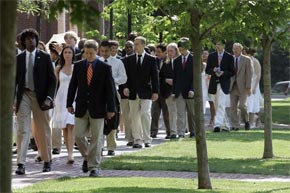
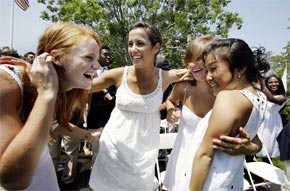
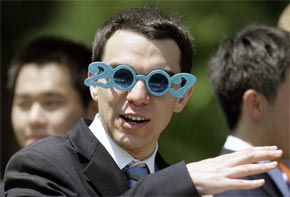
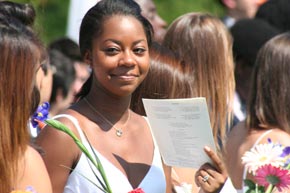
Graduation Speakers
Sarah Sze ’87
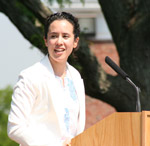
Dr. Robin Robertson, Head of School
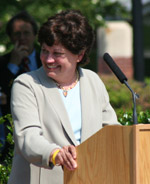
Kabeer Parwani ’07

Jee-Ahn Suh ’07

